Old Jerusalem Geography
I am aware jeneral is actually spelled general. But where's the fun in that? By now I've had a few posts about Jerusalem, including posts about the Kotel Tunnels and Ramparts Walk, Old City Jerusalem Tips, and Jesus' Tombs. This post is more about the lay out of Jerusalem and all the things I did not get to cover in the other posts.  |
Important places of Christianity (the Mount of Olives back right), Islam (Dome of the Rock Mosque), and Judaism (Wailing Wall) can be seen from this vantage point.
|
The Jewish Quarter
Jerusalem is divided into four quarters, although not all are the same size. The Jewish Quarter is one of the larger quarters. Within its bounds are not just houses and synagogues, but also the Western Wall (also called the Wailing Wall) and well preserved Roman Ruins.
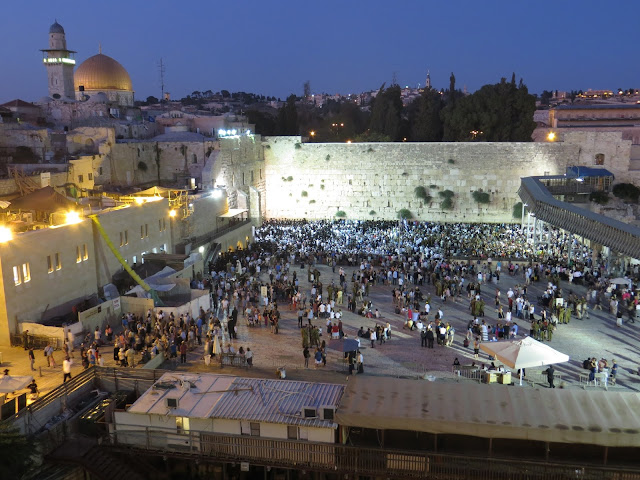 |
| Shabbat prayers at the Wailing Wall every Friday evening. |
The Western Wall bounds the Eastern side of the Jewish Quarter. It is the closest Jews can currently get to the area where their temple once stood. The Western Wall is actually there Western side of the Temple Mount, a large platform built by Herod the Great/Herod the Builder on which he placed the largest of the Jewish temples (there were multiple that kept getting destroyed). Now atop the Temple Mount is the Dome of the Rock, a Muslim controlled Mosque. Jews are not allowed to pray up in the Muslim-controlled area, so they pray at the Western Wall below it. To actually go up to the wall, visitors must don appropriate clothing (a yomika for men and no knees/shoulders/chest below the collarbone for women) and approach the wall in their gender-segregated area. The women's area is much smaller than the men's, just as at some of Holier sites of this area the men get synagogues to pray in while the women get small prayer rooms through which tours progress.
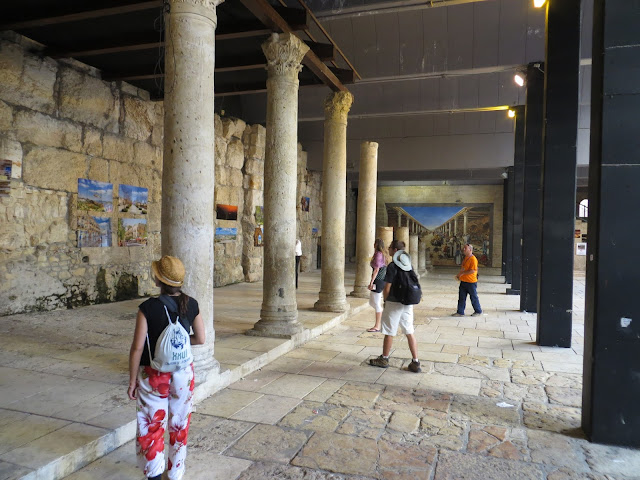 |
My friends and I explore the main Roman road that once crossed the entirety of Jerusalem, now preserved in the Jewish Quarter.
|
Another nice aspect of the Jewish Quarter is good preservation of archeological sites. Large sections of the old Roman road that once cut through the city have been restored. In the Muslim area, new buildings were just built on top of and in front of the old Roman road structures, making their streets not just, smaller and more crowded, but uglier as well. In the Jewish quarter even the columns with their majestic capitals (the decorative things at the top) have been righted and restored, allowing visitors to feel what it must have been like when Romans ruled the city.
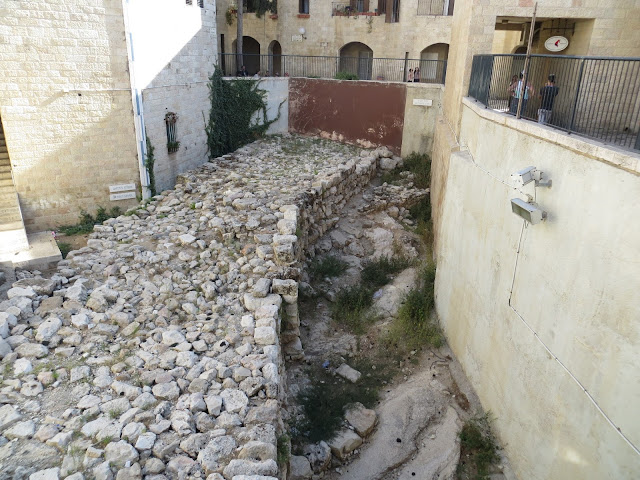 |
| A hastily built wall once a part of the city's exterior wall. |
Along with their excavation of the Roman thoroughfare the Jewish Quarter have also taken pains to excavate older sections of the Old City walls. Old Jerusalem was not always the size it is now. While for most of its history it was surrounded by a wall, the location of that wall changed with time. As Jerusalem expanded so did its wall. So periodically the old wall would be torn down, built over, and a new wall constructed on the new perimeter of the city. Today excavated portions of these older walls can be observed within the Jewish Quarter.
The Armenian Quarter
The Armenian Quarter of the Old City is the only quarter not named after a religion. The Armenaians earned a spot in the Old City during the crusades. During the period that the crusaders actually held Jerusalem they needed some help rebuilding it. So the crusaders invited Armenia (the first country to have Christianity as its state religion) to help rebuild the city one exchange for domain over a portion of it. Today the Armenian Quarter is the smallest and most secluded quarter of the city. It even has a wall around it, cutting it off from the rest of the Old City. I guess the Armenians like their privacy.
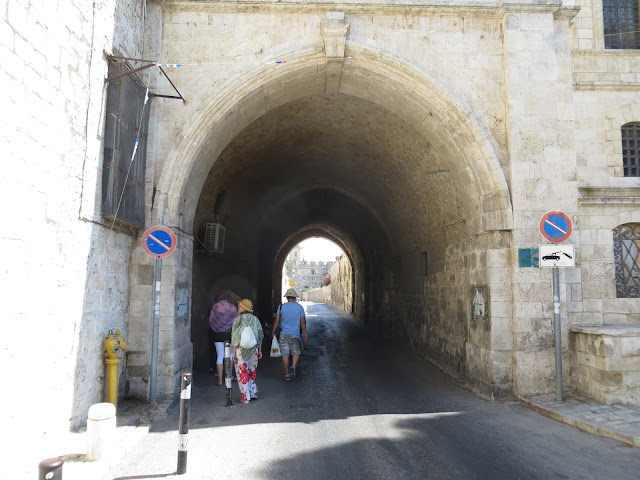 |
| To enter the Armenian Quarter, we had to pass through a set of walls that separate it from the rest of the Old City. |
In addition to being secluded, the Armenian Quarter is also largely undeveloped. There is a single church visitors can enter. A monastery and a few other privater residence also exist in this quarter, but what really dominates it are earthen parking lots. This by far is the easiest area within the Old City to find parking,
if the Armenians allow it. There is a reason for the plethora of parking in the Armenian Quarter. By law before building in any area of the Old City, the site must first be excavated to ensure no old important archeological sites will end up as the basement of a new building. In Old Jerusalem it is pretty much a guarantee that any archeological dig will turn up something. Not wanting to invite the Israeli government into their quarter to literally go digging around, the Armenians have chosen to leave much of their quarter undeveloped grass parking lots.
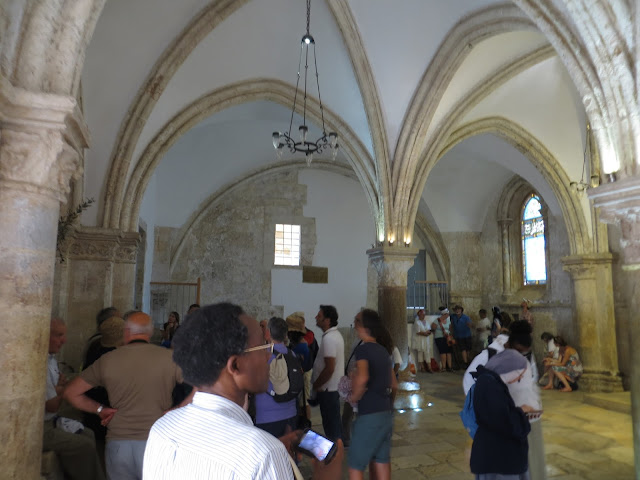 |
| The last supper room, which was actually built by crusaders who placed it in the approximate location of the actual last supper of Jesus. |
Despite the lack of attractions within the Armenian Quarter, some cool attractions exist in close proximity to it. Just outside the Old City walls of the Armenian Quarter is the room of the last supper. . . kind of. According to the signs posted all around it is called the Last Supper Room. One look at the Last Supper Room, with is pointed arches and column capitols and it felt like the room came out of the wrong era. Ask any tour guide or google, and the truth of the room comes out. The Last Supper Room was actually built by the crusaders in the area where the original room of the last supper was located. The previous building was destroyed in one of the many conflicts in the thousand years between Jesus' death and the crusades.
The Muslim Quarter
I found the Muslim Quarter to be a bit overwhelming. Our trip coincided with the end of Ramadan. Ramadan is a month in Islam in which Muslims fast during the daylight hours, only eating at night. Then the day after the end of Ramadan huge party is thrown in which Muslims eat to their heart's content. So not surprisingly the Muslim Quarter of the Old City was packed to the point that it was impossible to move in the press of bodies. We spent most of our trip trying to avoid the area, just so we could move around quickly enough to take in all the sights. The time we did spend in the Muslim Quarter was mostly limited to checking out the stations of the Via Dolorosa (stations of the cross) many of which are in the Muslim Quarter between the Mount of Olives and the
Church of the Holy Sepulchre.
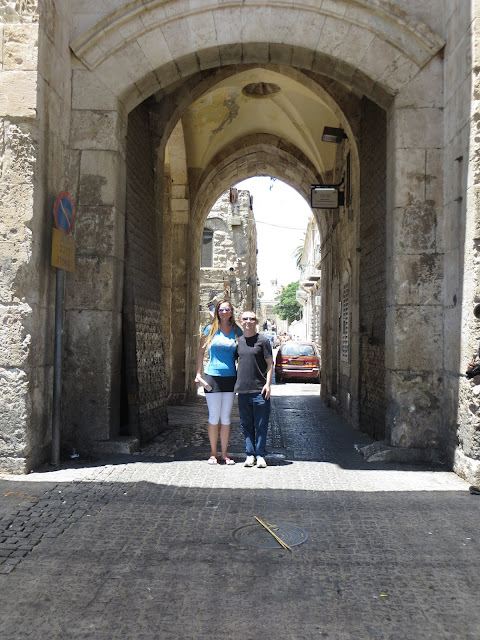 |
| The Lion Gate that leads into the Muslim Quarter from outside the Old City. |
One big attraction we did not get to see in the Muslim Quarter is the Dome of the Rock. The Dome of the Rock (which can be seen in the first quarter of this post) is a Mosque built on top of the Temple Mount. Within the mosque is a large rock important to both Judaism and Muslims. The rock is both the corner stone of the last Jewish temple and the rock from which Mohamed ascended into heaven from to meet God and other heavenly beings. Non-muslims are not allowed into the mosque with the rock, but they can walk the grounds surrounding the mosque for a couple of hours in the morning and an hour in the afternoon during the week. Since we were there on the weekend (weekends are Fridays and Saturdays in Israel) we were unable to visit the grounds surrounding the mosque.
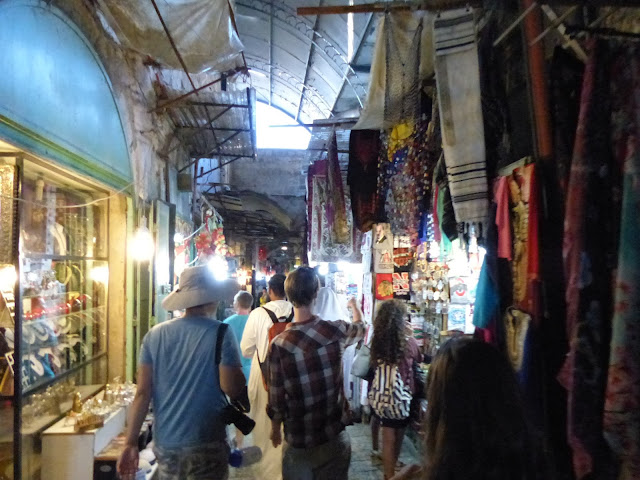 |
| Making our way through the extensive shops and narrow passageways of the Muslim Quarter. |
A few days after we left Jerusalem there was actually a series of riots around and within the Dome of the Rock. On a Jewish holiday (Tishsa B'Av) which commemorates the destruction of the first and second temples with a twenty five hour fast (too much fasting in Jerusalem for me) a Hasidic Jewish teenager tried to pray on the Temple Mount (where Jews are not allowed to pray) whilst Muslims tried to prevent Jews and then Israeli police from entering areas of the complex. I am not completely sure which events happened first. Even though I tried to find out from news reports it never became clear. What I do no is that some people were hurt and a lot of angry emotions were stirred in the Muslim and Jewish communities, which makes me sad.
The Mount of Olives
The Mount of Olives is not actually in the Old City, but it is a big tourist destination for Christians visiting Jerusalem. I really liked the Mount of Olives for one specific reason. It is the only place where we can connect a place to something that happened to Jesus. I talked earlier in this post about how the Last Supper Room is just a room in an area where the Last Supper supposedly happened. I wrote an entire post about the two places disputed to be
Golgotha and the tomb of Jesus on opposite sides of the city. However, the Bible is explicitly clear that the summit of the Mount of Olives is where Jesus rose into heaven (provided you are a Christian and believe in Jesus' ascent into heaven).
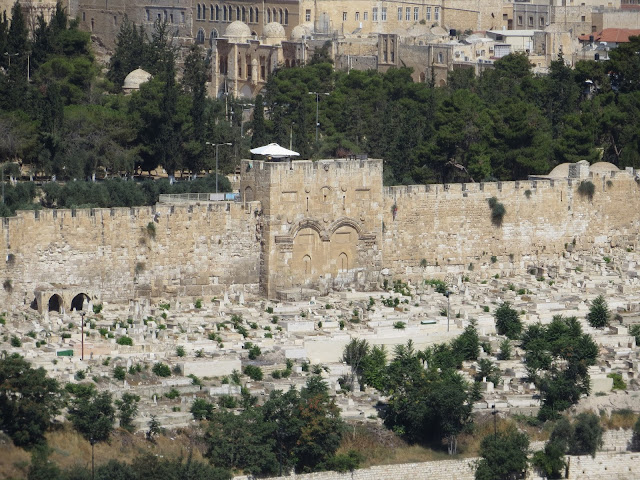 |
| The Golden Gate, now closed, which Jewish prophesy foretells the Messiah will ride through into Jerusalem. Jesus rode a donkey through this gate on Palm Sunday. Several muslims were buried in front of the gate in the hopes that it will prevent the coming of the Jewish Messiah, which kind of a way of conceding that their religion (Islam) might be wrong. |
The Mount of Olives is also important to Islam, as muslims believe on the day of reckoning a bridge will appear from the Mount of Olives summit to the Golden Gate (now permanently closed) across which all humanity must cross to enter into Jerusalem and paradise. Those who are unworthy will fall into the valley between the gate and the mount. So at the summit of the Mount of Olives are a chapel and a mosque side by side, without incident as far as I know. It seemed a very peaceful place when we were there.
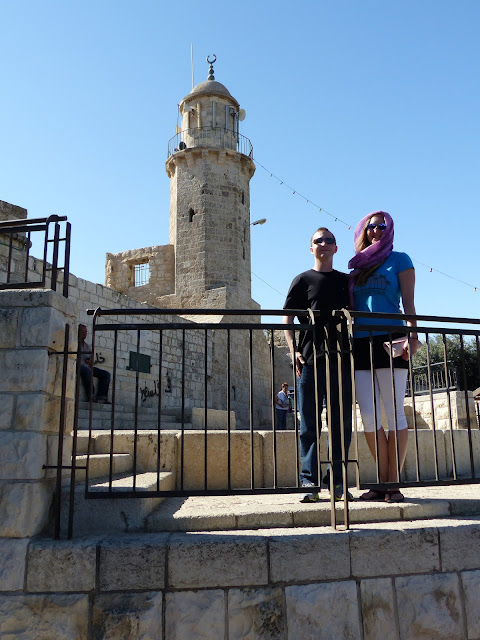 |
| In front of the mosque at the Mount of Olives summit, adjacent to the chapel commemorating Jesus' ascent into heaven. |
After our brief visit in the Mount of Olives chapel, which lacks decoration and is tiny, we walked across the street and downhill to take in the view of the Old City. From the many view points on the Mount of Olives, almost all of Jerusalem can be seen, including the famous Golden Gate. This gate which to Muslims is used as a way of keeping the riff raff out of paradise is significant to the jewish and Christian religions. According to Judaism, it is the gate through which the Messiah will pass on his way into Jerusalem. For Christians, the Messiah already came and as proof, Jesus was carried through that same gate a week before his death on a donkey, now commemorated with Palm Sunday, the Sunday before Easter.
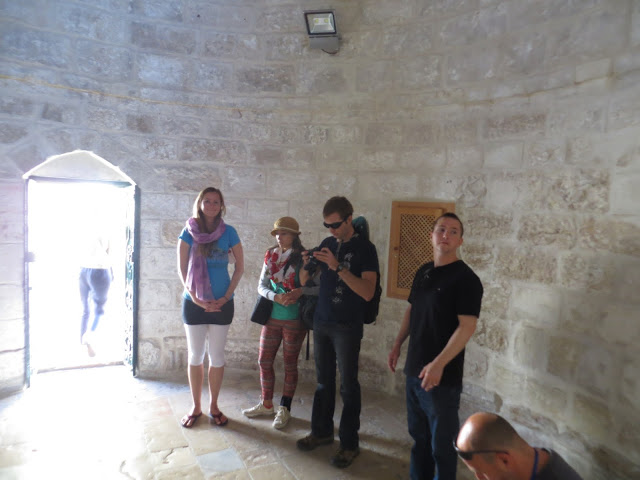 |
| Inside the small Mount of Olives chapel. I don't think anyone else noticed the camera taking photos of us. |
The view of the Old City and the Golden Gate is unobstructed, because that side of the Mount of Olives is a cemetery. Some Muslim tombs reside right outside the gate, as a method of preventing the Jewish Messiah from entering the city, which is kind of ironic. The rest of the hill side is covered in Jewish tombs. Jews who want to be the first to follow the Messiah into heaven (and have A LOT of money to purchase a plot here) are buried in the Mount of Olives cemeteries. I say cemeteries, because different cemeteries exist for different sects of Judaism.
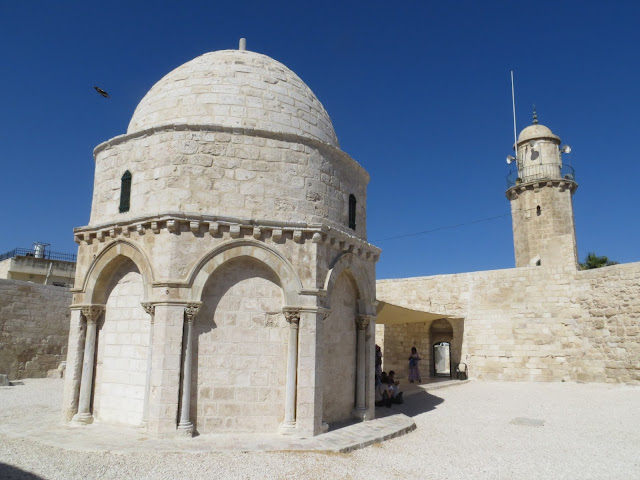 |
| The tiny Mount of Olives chapel is surrounded by an empty courtyard. |
Progressing down the Mount of Olives toward the Old City brings Christians to several more important locations in the Biblical story. There is a church built to commemorate where Jesus wept over the coming destruction of Jerusalem (Jerusalem was ransacked in 70 AD when the temple was destroyed again). Below that church is the Church of All Nations, built with money from several different countries (including the USA, Australia, Brazil, and Germany to name a few) in the heart of the Garden of Gathsemane, famous as the location where Jesus prayed to not have to be crucified while his disciples napped near by. I thought Gathsemane was pretty cool, since the olives trees within could date back to the time Jesus walked the earth. Olive trees never really die. When a tree dies a clone sprouts up from its trunk, meaning olives trees could in theory live forever. I am amazed by such feats of nature and was happy to see some supper old living beings.
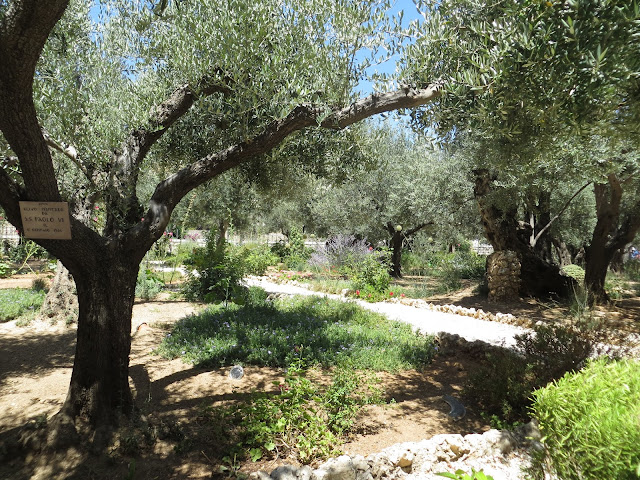 |
| The Garden of where Jesus prayed before being arrested. |
Nearby Gathsemane are a whole host of other Jesus-related attractions appealing to various sects of Christianity while not at all to others. There is a grotto where supposedly Jesus was arrested, and some tombs that supposedly held famous saints like his father Joseph, and so on. Across the street from all these attractions is the entrance to the Muslim Quarter at the Lions Gate and the Via Dolorosa which leads across the city to the Christian Quarter.
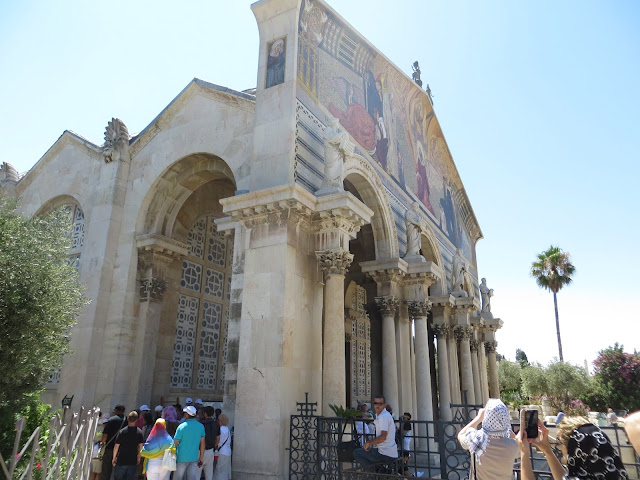 |
| The Church of All Nations built with money from several different countries to provide a space for people to pray and take communion in the Garden of Gathsemane. |
The Christian Quarter
By far the most famous attraction in the Christian Quarter is the
Church of the Holy Sepluchre. I am not going reiterate my visit to that church here, but instead want to talk about some of the other attractions in this Quarter. Probably my favorite being the Queen Helen Coptic Orthodox Church. This tiny little chapel is built above a water cistern used to provide drinking water to the builders of the
Church of the Holy Sepluchre around the corner. It is a steep and narrow trek down some slippery stairs into the cistern which opens up into a large holing tank, which still fills naturally with water. Right on the path of the Via Dolorosa, this church is hard to miss.
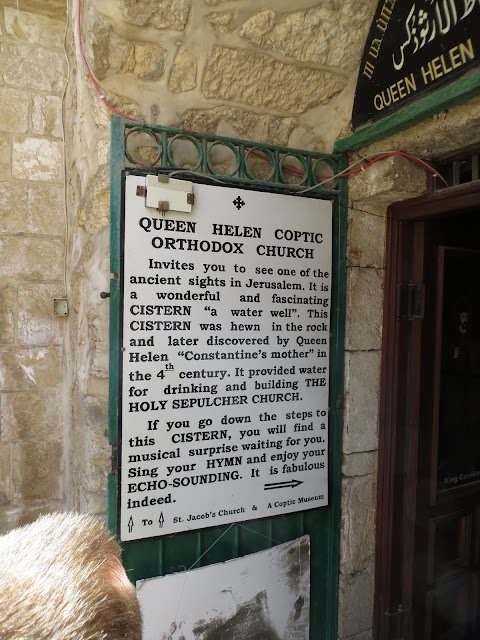 |
| One of the many little random churches in the Christian Quarter. |
Another church we visited in the Christian Quarter was the Lutheran Church a stone's throw from the
Church of the Holy Sepluchre. I was raised Lutheran and wanted to see how their church contrasted with the mayhem of the
Church of the Holy Sepluchre. What I found was a clean undecorated interior of a large mostly empty church with a grand bell tower, much like the Lutheran Church of Reykjavik in Iceland. The Church of the Redeemer in Jerusalem is co-managed by several Lutheran organizations, including the Evangelical Lutheran Church of America, one of the largest Lutheran synods in the US. Services are offered in Arabic, German, Danish, and English. Probably my favorite factoid about the Church of the Redeemer has to do with its dedication.
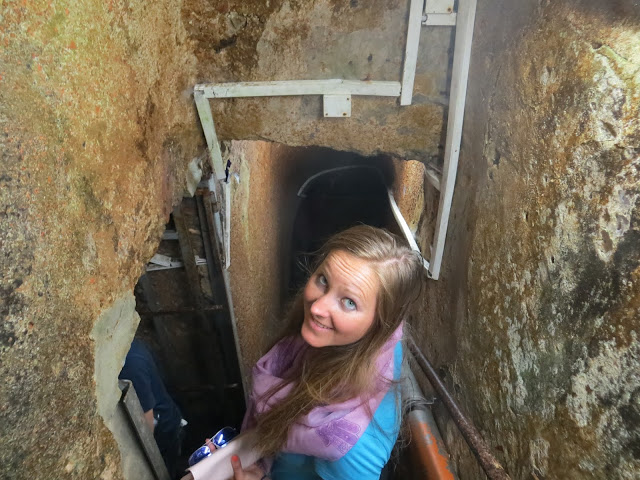 |
| Climbing down to the water cistern below the Coptic Church. |
The Church of the Redeemer was dedicated on Reformation Day (a Lutheran holiday celebrating Martin Luther nailing the ninety-five theses to a Catholic church door) in 1898 by Kaiser Wilhelm II. Kaiser Wilhelm who paid for and organized the building of the church really wanted to ride his grand carriage into Old Jerusalem at Jaffa Gate. Unfortunately Jaffa Gate (now a pedestrian walkway) was too small to accommodate his grand carriage. So he and the Ottomans tore down a section of the Old City wall for the Kaiser to pass through in his carriage, because nothing says "I come in Peace" like destroying a section of a city's defenses. Today this obliterated section of wall is a small road and still the only section of missing wall around the Old City.
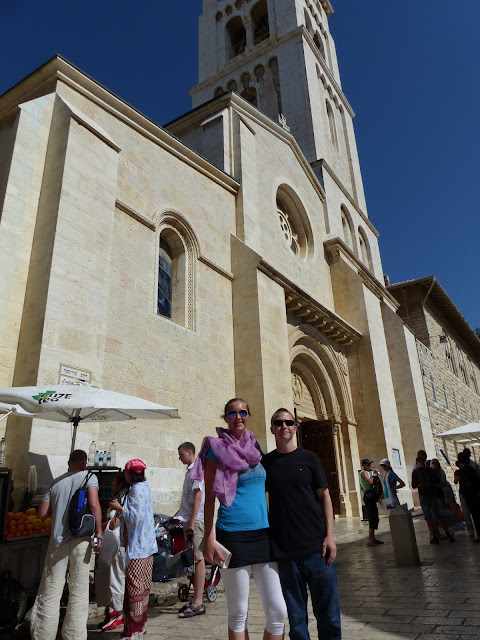 |
| The Lutheran church around the corner from the Church of the Holy Sepluchre. |
The West Bank
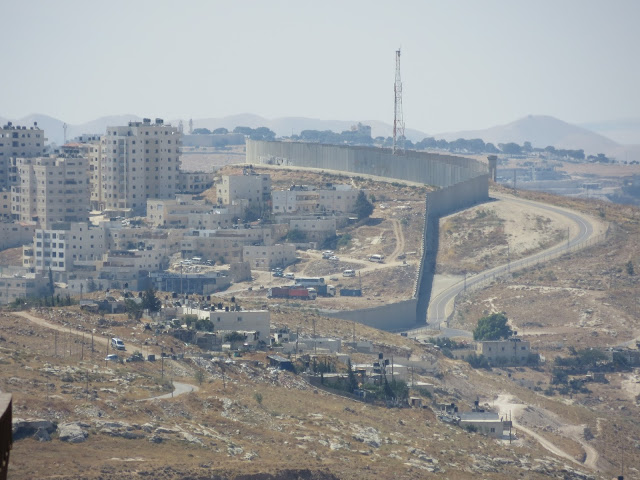 |
| The view of the West Bank from the Old City of Jerusalem. A new wall separates Jerusalem from the West Bank. |
One thing visible throughout much of Old Jerusalem is the wall separating the West Bank from the rest of Israel. This wall was constructed in the early 2000s to stop the rash of bombings by Palestinian protestors/terrorists in Jerusalem. The barrier is highly controversial. While it stopped the weekly bombings and attacks, it also prevented honest upright Palestinians from commuting to work in Jerusalem causing a depression in the West Bank economy. Like in the US where migrant workers fill the jobs US citizens don't want to, Palestinians for a long time filled the unwanted jobs of Jerusalem. Those jobs are now filled by immigrants. Having the barrier so close and often visible during our time in Jerusalem was a constant reminder of the challenges this area of the world still faces.

No comments:
Post a Comment